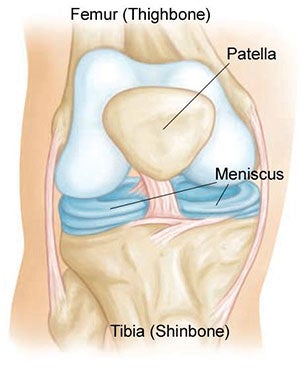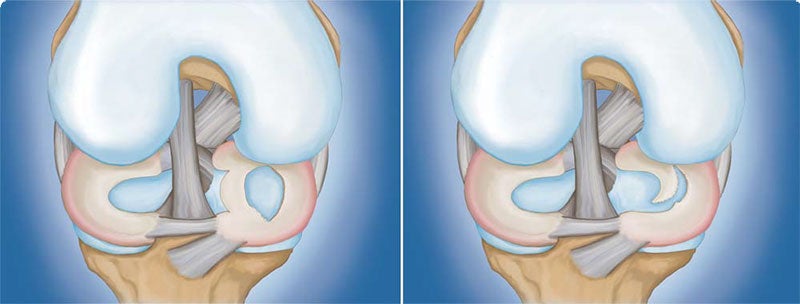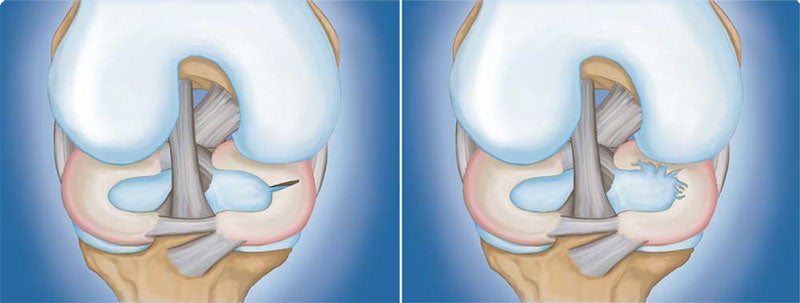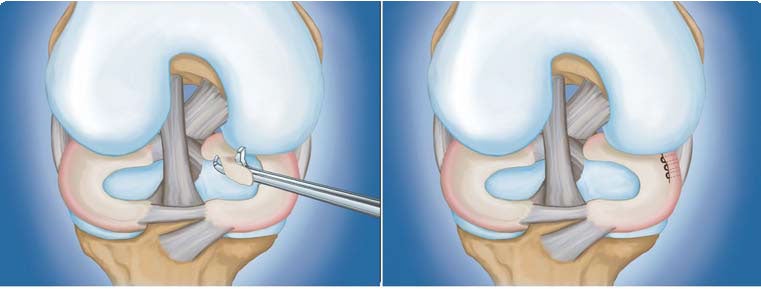
Meniscus tears are among the most common knee injuries. Athletes, particularly those who play contact sports, are at risk for meniscus tears. However, anyone at any age can tear a meniscus. When people talk about torn cartilage in the knee, they are usually referring to a torn meniscus.
Three bones meet to form your knee joint: your thighbone (femur), shinbone (tibia), and kneecap (patella). Two wedge-shaped pieces of cartilage act as "shock absorbers" between your thighbone and shinbone. These are called meniscus. They are tough and rubbery to help cushion the joint and keep it stable.
Menisci tear in different ways. Tears are noted by how they look, as well as where the tear occurs in the meniscus. Common tears include bucket handle, flap, and radial. Sports-related meniscus tears often occur along with other knee injuries, such as anterior cruciate ligament tears.

Caption: (Left) Bucket handle tear. (Right) Flap tear.

Caption: (Left) Radial tear. (Right) Degenerative tear.
What causes a meniscus tear?
Sudden meniscus tears often happen during sports. Players may squat and twist their knee, causing a tear. Direct contact, like a tackle, is sometimes involved. Older people are more likely to have degenerative meniscus tears. Cartilage weakens and thins over time. Aged, worn tissue is more prone to tears. Just an awkward twist when getting up from a chair may be enough to cause a tear, if the menisci have weakened with age.
What are the symptoms of a meniscus tear?
You might feel a "pop" when you tear a meniscus. Most people can still walk on their injured knee. Many athletes keep playing with a tear. Over 2 to 3 days, your knee will gradually become more stiff and swollen.
The most common symptoms of meniscus tear are:
- Pain
- Stiffness and swelling
- Catching or locking of your knee
- The sensation of your knee "giving way"
- You are not able to move your knee through its full range of motion
Without treatment, a piece of meniscus may come loose and drift into the joint. This can cause your knee to slip, pop, or lock.
How is torn meniscus diagnosed?
After discussing your symptoms and medical history, your doctor will examine your knee. He or she will check for tenderness along the joint line where the meniscus sits. This often signals a tear.
One of the main tests for meniscus tears is the McMurray test. Your doctor will bend your knee, then straighten and rotate it. This puts tension on a torn meniscus. If you have a meniscus tear, this movement will cause a clicking sound. Your knee will click each time your doctor does the test.
What tests can diagnose a torn meniscus?
Because other knee problems cause similar symptoms, your doctor may order imaging tests to help confirm the diagnosis.
- X-rays. Although x-rays do not show meniscus tears, they may show other causes of knee pain, such as osteoarthritis.
- Magnetic resonance imaging (MRI). This study can create better images of the soft tissues of your knee joint, like a meniscus
How your orthopedic surgeon treats your tear will depend on the type of tear you have, its size, and location. The outside one-third of the meniscus has a rich blood supply. A tear in this "red" zone may heal on its own, or can often be repaired with surgery. A longitudinal tear is an example of this kind of tear.
The inner two-thirds of the meniscus, however, lacks a blood supply. Without nutrients from blood, tears in this "white" zone cannot heal. These complex tears are often in thin, worn cartilage. Because the pieces cannot grow back together, tears in this zone are usually surgically trimmed away.
Along with the type of tear you have, your age, activity level, and any related injuries will factor into your treatment plan.
How is a torn meniscus treated without surgery?
If your tear is small and on the outer edge of the meniscus, it may not require surgical repair. As long as your symptoms do not persist and your knee is stable, nonsurgical treatment may be all you need. The RICE protocol is effective for most sports-related injuries. RICE stands for Rest, Ice, Compression, and Elevation:
- Rest. Take a break from the activity that caused the injury. Your doctor may recommend that you use crutches to avoid putting weight on your leg.
- Ice. Use cold packs for 20 minutes at a time, several times a day. Do not apply ice directly to the skin.
- Compression. To prevent additional swelling and blood loss, wear an elastic compression bandage.
- Elevation. To reduce swelling, recline when you rest, and put your leg up higher than your heart.
Non-steroidal anti-inflammatory medicines. Drugs like aspirin and ibuprofen reduce pain and swelling.
How is a torn meniscus treated with surgery?
If your symptoms persist with nonsurgical treatment, your doctor may suggest arthroscopic surgery.

Illustration and photo show a camera and instruments inserted through portals in a knee.
Knee arthroscopy is one of the most commonly performed surgical procedures. A small camera is inserted through a small incision (portal). This provides a clear view of the inside of the knee. Your orthopedic surgeon inserts small surgical instruments through other portals to repair the tear.
- Partial meniscectomy. In this procedure, the damaged meniscus tissue is trimmed away.
- Meniscus repair. Some meniscus tears can be repaired by suturing (stitching) the torn pieces together. Whether a tear can be successfully treated with repair depends upon the type of tear, as well as the overall condition of the injured meniscus. Because the meniscus must heal back together, recovery time for a repair is much longer than from a meniscectomy.

(Left): Close-up of partial meniscectomy. (Right): A torn meniscus repaired with sutures.
Once the initial healing is complete, you will be taught rehabilitation exercises. You will need to do regular exercises to restore your knee mobility and strength. You will start with exercises to improve your range of motion. Strengthening exercises will gradually be added to your rehabilitation plan.
For the most part, rehabilitation can be carried out at home, although your doctor may recommend physical therapy. Rehabilitation time for a meniscus repair is about 3 months. A meniscectomy requires less time for healing — approximately 3 to 4 weeks.
